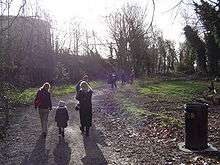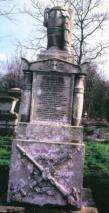Tower Hamlets Cemetery Park
|
Gravestones in Tower Hamlets Cemetery | |
| Details | |
|---|---|
| Established | 1841 |
| Location | Bow, Tower Hamlets, London |
| Country | England |
| Coordinates | 51°31′25″N 0°01′50″W / 51.52367°N 0.03042°W |
| Type | Public |
| Owned by | Tower Hamlets London Borough Council |
| Size | 10.93 hectares (27.0 acres)[1] |
| Number of interments | 350,000 |
| Website | Official website |
Tower Hamlets Cemetery Park is a historic cemetery located in Bow in the East End of London. The cemetery opened in 1841 and closed for burials in 1966. It is now a nature reserve, and other land has been added to the park, including "Scrapyard Meadow". It was originally named The City of London and Tower Hamlets Cemetery but was called Bow Cemetery by locals.
Tower Hamlets Cemetery was formally consecrated by the Bishop of London prior to being opened for the reception of bodies.
Location
The Main Gate is on Southern Grove (on the crossing with Hamlets Way in Mile End) which the cemetery park is situated in the Bow area of London, E3 and is in the London Borough of Tower Hamlets. There are also small gates on Hamlet Way and Cantrell Road. The nearest tube stations are Mile End and Bow Road.
History
Before the Victorian Era, all of London's dead were buried in small urban churchyards, which were so overcrowded and so close to where people lived, worked and worshipped that they were causing disease and ground water contamination.
An Act of Parliament was passed which allowed joint-stock companies to purchase land and set up large cemeteries outside the boundaries of the City of London. There were seven great cemeteries (the "Magnificent Seven") laid out about the same time (1832–41). Highgate Cemetery, where lots of famous dignitaries are buried, is the most well known: the others are Nunhead, West Norwood, Kensal Green, Brompton, Abney Park.
The City of London and Tower Hamlets Cemetery Company was made up of eleven wealthy directors whose occupations reflect the industries of the day: corn merchant, merchant ship broker and ship owner, timber merchant, and Lord Mayor of the City of London. The company bought 27 acres (109,265 m2) of land and the cemetery was divided into a consecrated part for Anglican burials and an unconsecrated part for all other denominations.

Tower Hamlets Cemetery was very popular with people from the East End and by 1889 247,000 bodies had been interred (the cemetery remained open for another 77 years). In the first two years 60% of the burials were in public graves and by 1851 this had increased to 80%. Public graves were the property of the company and were used to bury those whose families could not afford to buy a plot. Several persons, entirely unrelated to each other, could be buried in the same grave within the space of a few weeks. There are stories of some graves being dug 40 feet deep and containing up to 30 bodies.
The cemetery itself did not remain in a tidy and elegant state for long. Only 55 years after it was opened it was reported to be in a neglected state. During the Second World War the cemetery was bombed five times during raids on the City of London; both cemetery chapels were damaged[2] and shrapnel damage can be seen on the graves by the 1994 Soanes Centre in the north-west corner of the park. Burials continued taking place until 1966, when the Greater London Council (G.L.C.) bought the company for £100,000 under the G.L.C.(General Powers) Act and the ground was closed for burials. The intention was to create an open space for the public and relevant parts of the cemetery were freed from the effects of consecration. In October 1967 a further £125,000 was spent clearing the chapels and 0.68 acres (2,752 m2) of graves. Strong local opposition and problems of funding stopped the clearance.

Tower Hamlets London Borough Council took over its ownership in 1986. It was declared a Local Nature Reserve in May 2000 along with adjacent open land on Cantrell Road and Ackroyd Drive. It has also been designated as Site of Metropolitan Importance for Nature Conservation and a Conservation area. The high brick walls which surround it are on the national register of listed buildings as are 7 individual memorials (all Grade II).
The Friends of Tower Hamlets Cemetery Park are a group of locals who came together in 1990 because they were concerned over the increasing neglect by successive owners. Their main objectives are to encourage greater use of this inner urban green space as a sanctuary for people and a place of biodiversity. The park has been designated a Local Nature Reserve.[3][4]
The cemetery now resembles natural woodland, with many bird and insect species making it their home.
Notable burials

Those who are buried or have memorials here include:
- Dr Rees Ralph Llewellyn — Performed autopsy on Mary Ann Nichols, generally considered the first victim of Jack the Ripper
- Alexander Hurley — Singer and comedian, second husband of Marie Lloyd
- John "White Hat" Willis — Original owner of the Cutty Sark
- Alfred Linnel — Trampled by a police horse during a demonstration in Trafalgar Square. His funeral was organised by Annie Besant and William Morris
- Will Crooks — Trade unionist and first Labour Mayor of Poplar
- Hannah Maria Purcell — Widow of William Purcell, carpenter of HMS Bounty
- Some victims of the Bethnal Green Disaster
- Charles Jamrach — Animal supplier to P. T. Barnum and others.
- Henry Norris — Civil Engineer of lighthouses for Trinity House
- John Buckley VC- soldier
War Graves
There are 279 Commonwealth service personnel of both World Wars buried here, the names of all being listed on bronze panels on a Screen Wall memorial, as are those of four Dutch merchant seamen. Nine British merchant seamen are buried here who were killed when their ship, SS Bennevis, was hit by a bomb while berthed in the Pool of London during an air raid in World War II.[2]
| Wikimedia Commons has media related to Tower Hamlets Cemetery. |
References
- ↑ "Tower Hamlets A - Z of Parks". Tower Hamlets Council. n.d. Retrieved 29 September 2013.
- 1 2 CWGC Cemetery Report.
- ↑ "Tower Hamlets Cemetery Park". Local Nature Reserves. Natural England. 31 July 2013. Retrieved 23 January 2014.
- ↑ "Map of Tower Hamlets Cemetery Park". Local Nature Reserves. Natural England. Retrieved 23 January 2014.
External links
Coordinates: 51°31′24″N 0°01′36″W / 51.5232°N 0.0267°W

